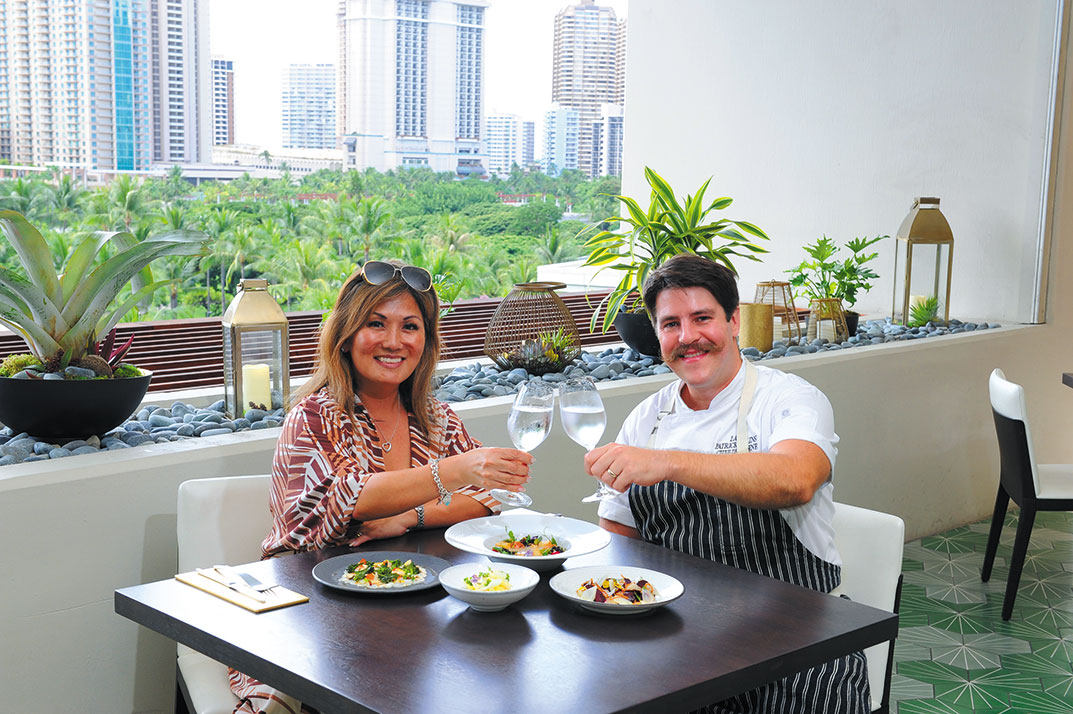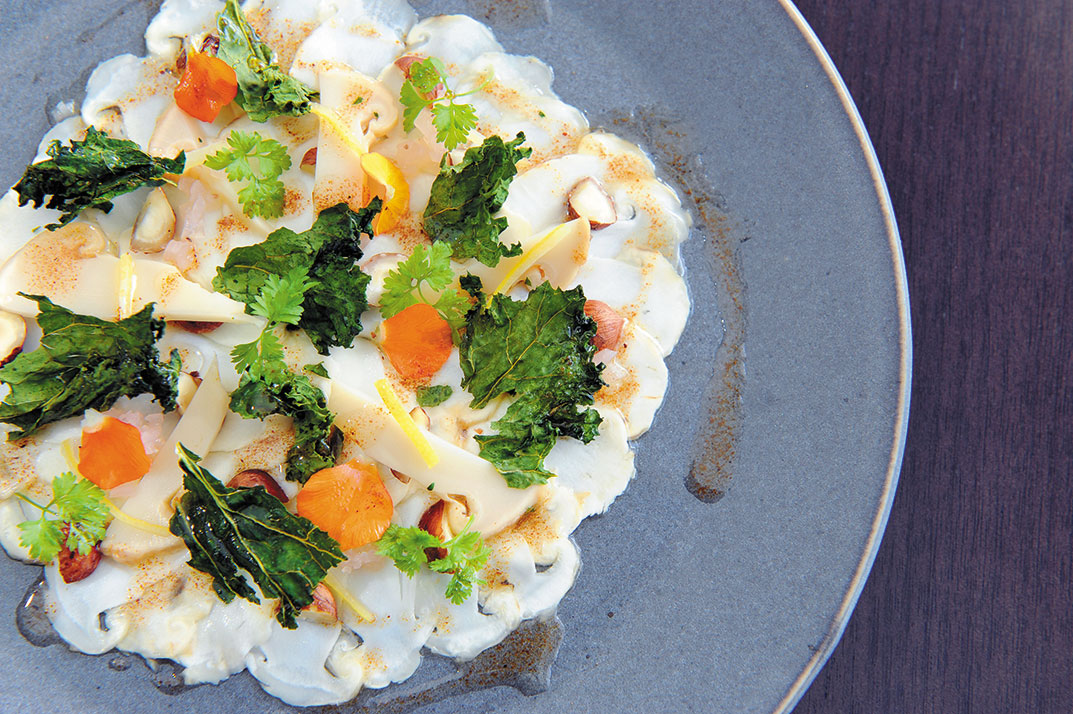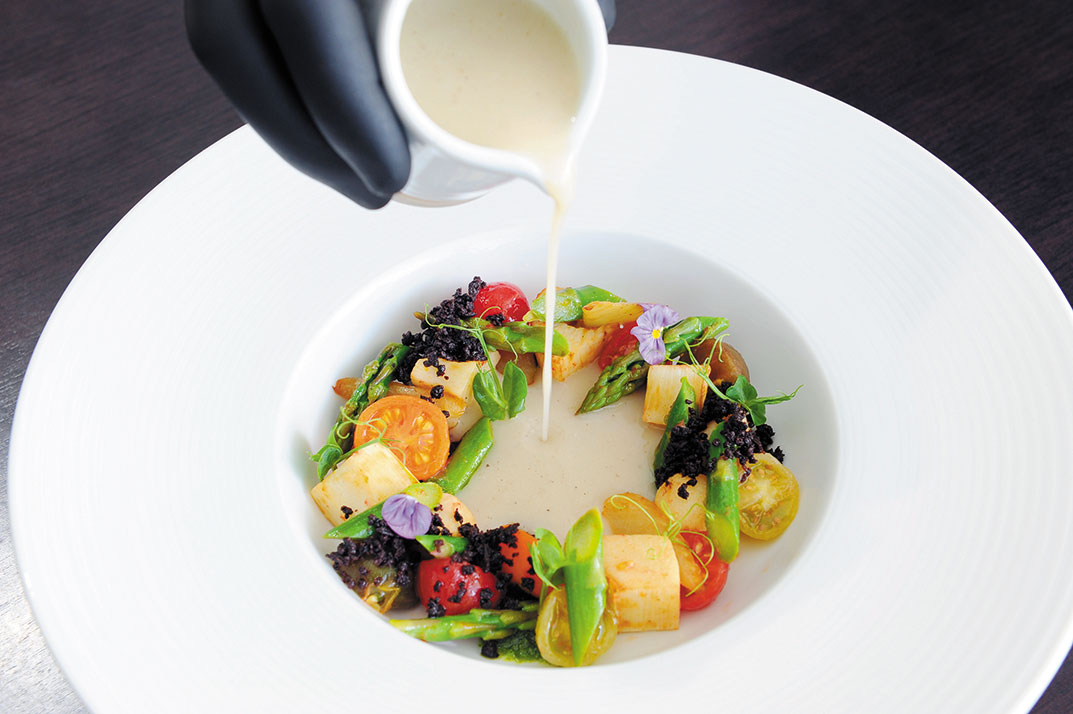
Anne Lee and La Vie chef de cuisine Patrick Collins toast to the restaurant’s new vegetable selections menu.
ANNE LEE speaks with La Vie chef de cuisine PATRICK COLLINS
Chef de cuisine Patrick Collins creates temporary art at La Vie. This celebrated chef has been asked to sign menus from guests that enjoyed his cuisine, but instead of just signing his name, he has the whole team sign it. Growing up across the world has fostered in him a unique palate. I was fortunate to spend time with chef Patrick, as he shared his experiences and passion for cooking.
AL: How did you get started in the culinary industry?
PC: I moved to New York when I was 18. I was born in California; grew up in Switzerland. We moved around and followed oil — my father worked for ExxonMobil — to Norway and Scotland. Living in different places solidified my passion for cooking.
AL: What brought you to Hawaii?
PC: I came to Hawaii about five years ago, as a result of my wife. We met working together in Switzerland and we always talked about our love for Honolulu and coming back here one day. I started my career in Hawaii working at Senia with Chris Kajioka.
AL: Tell me about your childhood.
PC: There were six of us. Dinner time was when we got together and enjoyed each other’s company. It wasn’t so much the food; it was the communal aspect, going to restaurants or having people over and what that whole experience means.
My high school counselor encouraged me to apply to culinary school, so I applied to The Culinary Institute of America.
AL: What is the intention of La Vie?
PC: Do something for somebody else in a way that they wouldn’t imagine it to be done. Obviously, hospitality is a huge part of it. Dusty Grable our general manager and Wes Inoshita, La Vie restaurant manager, incorporate that to every guest. We show a genuine type of hospitality, and we embody that to our kitchen team, as well. That’s why you see the menu built the way it is. By having items on the menu that work, people will naturally be able to get what they want, and not have to question price. COVID really made us understand what our local clientele wanted in the portion, experience, menu choices. From pescatarian, to vegetarian, to carnivore, we have a menu for everyone.
AL: You have a new vegetable selections menu. Tell me how this was inspired.
PC:We have taken from the vegan/vegetarian menu and streamlined it to this menu. All these things have an appropriate component to make them vegan options. Choosing what to eat is a personal thing, so we made the menu personal. You tell me what your distinctions are and we can provide that for you. At home, we cook with a lot of vegetables. It’s not hard to make something look appetizing with vegetables, as they are so colorful. My mother-in-law is from Hiroshima, and she almost exclusively cooks with vegetables and fish.
We are not designing things for vegan or vegetarian, as I do not believe in making a meat substitute. Not one vegetable has everything in it. Many vegetables together are powerful. On the flip side, we do this for our meat and fish dishes, too. It would be bland without a bit of a garnish. The garnish with the snapper, for example, completes the dish.
AL: Can you describe the vegetable selections menu items?
PC:You can select three dishes to curate your experience (you can always order more than three) for $59, and beverage pairing for an additional $59.
Hamakua Heart of Palm (looks like a haku lei): garlic bread potage, provencal vegetables and black olive.
Marinated Beet Veronique: poached grapes, fennel and almond crème.
Celery Root Remoulade: a classic salad of julienne celery root and tartare sauce, served with light meats, fish and shellfish. Our vegetarian version focuses on the texture and robust flavor of celery root, treating it like a “crab salad.” Served over avocado dressed with lemon and pistou (French pesto minus nuts and cheese); garnished with granny smith apple, endive and vadouvan curry salt.
Matsutake Carpaccio is not listed on the menu; this is one of our specials. We try to do seasonal specials until we can’t get the ingredients anymore. This will be available for a limited time. This features thin shaved matsutake mushroom from Oregon served in the “Italian style”: dressed with brown butter, pickled shallot and lemon zest; garnished with kale chips, hazelnuts and last year’s preserved matsutake.
AL: Tell me about the local farmers you work with.
PC:Hirabara Farms in Waimea, their baby fennel is not little, it’s just a beautiful fennel. The quality of their produce is meticulously grown and perfect. The produce we use is very important; it’s worth it for us to pay more for exceptional products so we can provide that back to our guests. With COVID, I realized there were a lot of things that I wasn’t able to get, so without places like our local farmers, we wouldn’t be able to get quality items. Our G. Lion Hawaii philosophy is to work with community. Our purveyors are important as without them, we can’t do what we do.
AL: Anything else you’d like to share?
PC: One of the focuses that we want to do is to share the seasonal ingredients that make up the traditional French repertoire. We want to do truffle dishes, Matzutake mushroom dishes, white asparagus. We want to celebrate the beautiful vegetable options and give accessibility to our guests that might not have access to these items.
See more articles from: La Vie




